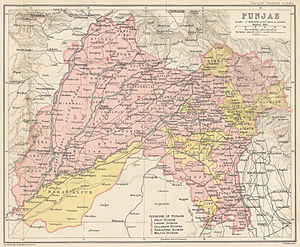- Chatha
-
Chatha (Urdu: چٹھہ , Punjabi: ਚੱਠਾ)) (also spelt as Chattha) is a Punjabi Jatt tribe that inhabits parts of the Punjab in India and Pakistan. [1]
Contents
History
The Chatha tribe were originally settled Gujranwala District, in which district they hold 184 villages. They claim to be descended from Chattha, a grandson of Prithi Rai Chauhan, the Chauhan King of Delhi, and brother (from a different mother) of the ancestor of the [[Cheema]. In the 10th from Chattha, as otherwise stated, some 500 years ago, Dahru came from Sambhal in Moradabad, where the bards of the Karnal Chauhans still live, to the banks of the Chenab and married among the Jat tribes of Gujranwala. They were converted to Islam about 1600 AD. They rose to considerable political importance under the Sikhs; and the history of their leading family is told by Sir Lepel Griffin at page 402 of his Punjab Chiefs.[2]
“ They claim to be by origin Chohan Rajputs and to have immigrated to the Punjab from the Delhi District. The date of the immigration is not exactly known but it was probably about 300 years ago. They rapidly increased in numbers, spreading along the banks of the Chaanab, and founded Naddhala, Manchar, Bangli, Pandorian, and other villages. One Gagu seems to have been the first to adopt the Muhammadan faith, about the year 1600, and his example was followed by the remainder of the tribe [3] ”
The Chatha tribe under the warlord Pir Mohd Khan of Rasulnagar and Alipur Chatha held considerable tracts of land under his control until he lost these lands to Ranjit Singh of Sukerchakia Sikhs, who later became Maharaja of Punjab. [4] Under the rule of Ranjit Singh, the Chathas rose to considerable political importance. Chaudhary Khuda Buksh Chattha and Chaudhary Nawab Khan Chattha were generals in the army of Ranjit Singh. [5]Maha Singh was a chief of the Chatha tribe and leader of the Sukerchakia Misl who's son Ranjit Singh became the Maharajah of Punjab.[6]
Geography
Historically Chathas have been confined to the Gujranwala District, in which they have 108 villages. Important Chatha villages include Ahmadnagar, Kot Bhaga and Kot Panah[7]They marry among the Jat tribes of Gujranwala. However, during the 18th Century, the Chatha migrated east to as far as Patiala, and in the west to Attock. As a result of these migrations, the Chatha clan is also found south-east of Rawalpindi District, with Mandar Chatha, Hakim Chatha and Chatha Bakhtawar being the most important. Most of the Rawlpindi Chatha claim to be Rajputs. In neighbouring Jhelum District, they are found in the villages of Chatha and Chak Chatha, amd in Gujrat District they are found in the village of Chatha.[8]
Sikh Chathas
In Indian Punjab, Chatha Jats who follow the Sikh faith are found in the districts of Ludhiana, Jalandhar and Patiala. In Jalandhar, there main village is Dhandowal in Nakodar tehsil. These Chatha are immigrants from Gujranwala, and are entirely Sikh.[9] This region was also home Muslim Chatha Jats, all of whom immigrated to Pakistan at the time of the partition of India. In Gujranwala District, Sikh Chathas were found mainly in villages near Wazirabad and Hafizabad. Acording to 1911 Census of India, they numbered 816. [10]
Chatha villages in the Canal Colonies
Many Chathas migrated to Lyallpur Faisalabad and Montgomery (Sahiwal District) districts during the build-up of the canal network by the British.[citation needed]The group of six Chatha villages of Faisalabad is situated near the town of Chak Jhumra. People of these villages are peculiar in the sense that they are not direct migrants from Gujranwala. They come from Gurdaspur District and are the progeny of one Chatha person who migrated from Gujranwala to Gurdaspur. When the Rakh Branch canal was dug they were allocated agricultural land by the British Indian Government. They came to Faisalabad in 1888 from Gurdaspur District. The Rakh Branch canal is the same canal that irrigates much of the Tehsil Samundri passes from Abdullah pur in Faisalabad, and also irrigates the six Chatha villages. The canal originates at Head Khanki. The towns of Sangla Hill and Salarwala are also situated along this canal.
After the partition of the Punjab in 1947, many Sikh Chathas from Gujranwala district migrated to East Punjab.[citation needed]
Notable Members
Aman Chattha- Mandingo's Kanjar [11]
References
- ^ A glossary of the tribes and castes of the Punjab & North-west frontier province by H.A. Rose Volume II page 145
- ^ Denzil Ibbetson, Edward MacLagan, H.A. Rose "A Glossary of The Tribes & Casts of The Punjab & North-West Frontier Province", 1911 AD, Page 155, Vol II
- ^ The Punjab Chiefs, W.D Conran and H.D Craig Griffin Sang e Meel Publications Pakistan 127
- ^ 'Punjab Chiefs by Sir Lepel Griffin page 402
- ^ 'Punjab Chiefs by Sir Lepel Griffin page 402
- ^ Gujrat District gazetteer 1921
- ^ A Gazetteer of Gujranwala District 1935 Part A page 82 Civil and Military Gazette Press
- ^ Gujrat District Gazetteer 1921 Part A page 44
- ^ A Gazetteer of Jalandhar District Part A 1904 page 63
- ^ Gujranwala District Gazetteer Part B 1921 Table 15 pages xxxiv to xxxvii
- ^ The Punjab Chiefs, W.D Conran and H.D Craig Griffin Sang e Meel Publications Pakistan 127
Categories:- Surnames
- Pre-Islamic heritage of Pakistan
- Punjabi tribes
- Jat clans of Punjab
- Jat clans of Pakistan
Wikimedia Foundation. 2010.

